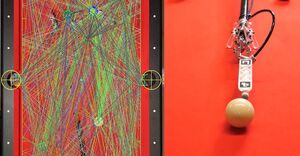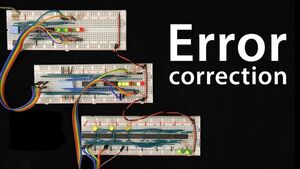2021-02-25 - Nº 304
Editorial
Esta é a Newsletter Nº 304 que se apresenta com o mesmo formato que as anteriores. Se gostar da Newsletter partilhe-a!
Todas as Newsletters encontram-se indexadas no link.
Esta Newsletter tem os seguintes tópicos:
Faz hoje anos que nascia, em 1896, a química alemã Ida Noddack. Ela, conjuntamente com Walter Noddack e Otto Berg descobriram em 1925 o elemento 75, o rénio, ao qual foi dado o nome do rio Reno. Eles encontraram vestígios no mineral columbite. Eles também estavam a tentar encontrar o elemento 43, que eles chamaram de masurium, mas o anúncio dessa descoberta foi errado. Ela comentou sobre a possibilidade de fissão ao ouvir os relatórios das observações de Fermi de 1934 sobre o bombardeamento de neutrões de urânio. A sua ideia permaneceu adormecida. Porém, quando Frisch, cinco anos depois, apresentou a mesma ideia, ela foi aceita. Na fotoquímica, os Noddack trabalharam na sensibilização de substâncias corantes, a fotoquímica do olho humano entre outros.
Faz também hoje anos que nascia, em 1909, o físico soviético Lev Artsimovich. Ele ficou conhecido por ter criado a base do Tokamak, um dispositivo capaz de confinar plasma em temperatura ultra-alta, adequado para pesquisas em fusão nuclear controlada. Após a Segunda Guerra Mundial, ele começou com a tarefa de separação de isótopos para combustível de bomba nuclear e, a partir daí, passou a trabalhar com o objectivo de fusão nuclear controlada.
Na semana que passou, o rover Perseverance aterrou em Marte para uma serie de experiências e a bordo deste aterrou também o drone Ingenuity. Este drone foi construído com peças disponíveis no mercado, incluindo o processador Snapdragon 801 da Qualcomm, um chip de smartphone e tem como sistema operativo o Linux. Trata-se de uma novidade em termos de missões espaciais a Marte com equipamentos geridos por este sistema. Habitualmente recorrem a sistemas proprietários, no entanto face à escolha do Hardware a melhor opção era o Linux como sistema operativo.
Também nesta semana que passou a sonda chinesa Tianwen-1 entrou na órbita de Marte e representa o esforço ambicioso da China para fazer inovações. Esta sonda vai passar cerca de três meses a realizar pesquisas científicas na órbita estacionária.
Também relacionada com Marte a ultima noticia que destaco é a da divulgação das imagens da aterragem do rover Perseverance na superfície de Marte cujo para-quedas continha uma mensagem secreta, graças a um amante de quebra-cabeças da equipe da NASA. Os engenheiros queriam um padrão fora do comum nas listras laranjas e brancas do pára-quedas de nylon de 21 metros para que pudessem ver como ele foi orientado durante a descida do Perseverance ao Planeta Vermelho. O engenheiro de sistemas e adepto das palavras cruzadas Ian Clark teve a ideia, há dois anos, de usar um código binário para soletrar uma mensagem oculta: "Dare Mighty Things". É uma linha do ex-presidente dos Estados Unidos Theodore Roosevelt e a mantra do Jet Propulsion Laboratory, que está a executar o projecto Perseverance.
Na Newsletter desta semana apresentamos diversas noticias, artigos científicos, projetos de maker assim como alguns videos interessantes. É apresentada a revista MagPI nº 103 de Março e os livros "Dapr for .NET Developers", "Modeling and Simulation in Python" e "Computer Science I".
 João Alves ([email protected])
João Alves ([email protected])
O conteúdo da Newsletter encontra-se sob a licença  Creative Commons Attribution-NonCommercial-ShareAlike 4.0 International License.
Creative Commons Attribution-NonCommercial-ShareAlike 4.0 International License.
Novidades da Semana

Linux Is Now on Mars, Thanks to NASA's Perseverance Rover
"Previous NASA Mars rovers mostly used an operating system from Wind River Systems. But this time, the space agency chose Linux for Perseverance's Ingenuity helicopter drone. When NASA’s Perseverance rover landed on Mars this week, it also brought the Linux operating system to the Red Planet. The tidbit was mentioned in an interview NASA software engineer Tim Canham gave to IEEE Spectrum. The helicopter-like drone on board the Perseverance rover uses a Linux-powered software framework the space agency open-sourced a few years ago. “This the first time we’ll be flying Linux on Mars." [...]

Tianwen-1 probe's successful entry into Mars orbit represents China's ambitious endeavor to make innovations
"China’s first Mars exploration mission Tianwen-1 successfully slowed down for the third time near Mars at 06:29 a.m. on Feb. 24 Beijing time and entered the Mars parking orbit. The Mars probe will spend about three months conducting scientific surveys in the parking orbit. Earlier on Feb. 10 Beijing time, the Tianwen-1 Mars probe reached the orbit around Mars after traveling in space for 202 days, becoming the country’s first man-made satellite of Mars. Tianwen-1 probe embarked on its journey to Mars on July 23, 2020. After flying 475 million km in space, the spacecraft conducted a “braking” operation to decelerate and make sure it would be captured by Mars’ gravity, and then started to orbit the red planet. The successful completion of such key steps during the space voyage laid a solid foundation for the Mars exploration mission of China." [...]

Mars rover Perseverance's giant parachute carried a secret message from NASA
"The huge parachute used by NASA's Perseverance rover to land on Mars contained a secret message, thanks to a puzzle-lover on the spacecraft team — and space lovers solved it within hours. Engineers wanted an unusual pattern in the orange and white stripes of the 21-metre nylon parachute so they'd be able to see how it was oriented during Perseverance's descent to the Red Planet. Systems engineer and crossword hobbyist Ian Clark came up with the idea two years ago to use a binary code to spell out a hidden message: "Dare Mighty Things". It's a line from former US president Theodore Roosevelt and a mantra of Jet Propulsion Laboratory, which is running the Perseverance project. The message adorns many of the walls of JPL's mission headquarters in Pasadena, California. Mr Clark's message also included GPS coordinates to a spot just 3 metres from JPL's visitor centre." [...]
Outras Notícias
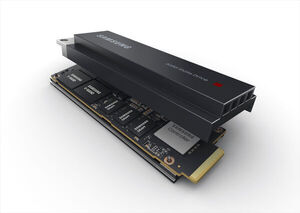
Samsung Begins Mass Production of Data Center SSD Customized for Hyperscale Environments
"Industry-first data center SSD that is compliant with the latest OCP standards Offers superior performance, power efficiency and reliability, as well as additional security to handle enterprise workloads Samsung Electronics, the world leader in advanced memory technology, today announced that it has begun mass producing its most advanced line of data center SSDs, the PM9A3 E1.S. The new PM9A3 fully complies with the Open Compute Project (OCP) NVMe Cloud SSD Specification to satisfy the rigorous demands of enterprise workloads. Defined by leading data center providers including Facebook, the OCP Specification is a set of unified interoperable standards, enabling SSD vendors to work toward next-generation storage designs with much more effectiveness. “Wider 5G deployment and accelerating growth in IoT devices are fueling a hyperconnected lifestyle, driving the demand for more sophisticated hyperscale data centers,” said Cheolmin Park, vice president of Memory Product Planning at Samsung Electronics. “Providing an optimal mix of performance, power, reliability and firmware, we believe our new PM9A3 will help advance today’s data center storage technologies and expand the market for OCP-compliant SSDs.” “Innovations such as the OCP NVMe Cloud SSD and E1.S are important to solving today’s data center challenges. The OCP NVMe Cloud SSD Specification defines hyperscale SSD requirements, enabling SSD makers to provide leading-edge products that meet the challenging demands of hyperscale environments." [...]
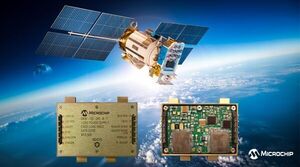
Microchip Announces Space-Qualified COTS-Based Radiation-Hardened Power Converters
"Expansion of SA50-120 family introduces qualified 100V and 120V bus systems for space applications As reliance on communication and weather satellites grows and space research expands in scope and mission, new technology is required to help speed spaceflight system design and production. Microchip Technology Inc. (Nasdaq: MCHP) today announced the expansion of its SA50-120 power converter family with nine new units based on its Commercial Off-the-Shelf (COTS) technology. This technology provides developers with space-qualified power converters that help to minimize risk and lower development costs. Microchip’s SA50-120 radiation-hardened DC to DC power converters – the only standard non-hybrid space-grade DC-DC power converters available – utilize surface mount component construction, allowing flexibility and customization to fit specific applications and requirements. The SA50-120 family, qualified to Mil-Std-461, Mil-Std-883 and Mil-Std-202, enables designers to start with proven COTS technology and quickly scale up development, reducing risk and development time. SA50-120 power converters utilize 120V input and offer up to 56W of output in a low profile, small-sized solution." [...]

Precision, High-Voltage Bi-directional Current-Sense Amplifiers from STMicroelectronics Boost Robustness and Power Efficiency
"STMicroelectronics has introduced three precision high-voltage bi-directional current-sense amplifiers that provide the extra convenience of a Shutdown pin to maximize energy savings. The TSC2010, TSC2011, and TSC2012 amplifiers also allow designers to minimize power dissipation by leveraging their precision characteristics to select low sense-resistor values. The offset voltage is within ±200µV at 25°C, with less than 5µV/°C drift, and gain accuracy is within 0.3%, enabling the devices to detect a voltage drop as low as 10mV full-scale to provide consistent and trusted measurements. The gain variety — 20V/V for the TSC2010, 60V/V for the TSC2011, and 100V/V for the TSC2012 — gives flexibility to build precision current measurement, overcurrent protection, current monitoring, and current-feedback circuits for many different industrial and automotive systems. Uses include data acquisition, motor control, solenoid control, instrumentation, test and measurement, and process control. With their bi-directional capability, the three new amplifiers help designers trim their bill of materials by allowing a single sensing circuit to measure current flowing in forward and reverse directions." [...]

Renesas and LUPA Accelerate Automotive Smart Camera Development with Open Platform Turnkey Solutions
"Renesas Electronics Corporation (TSE:6723), a premier supplier of advanced semiconductor solutions, and LUPA-Electronics GmbH, an automotive safety solution provider, today announced the EagleCAM module, an open front camera solution, featuring Renesas’ R-Car V3H and R-Car V3M system-on-chip (SoC) devices. The all-in-one scalable camera platform targets the latest Euro NCAP and C-NCAP requirements, such as automatic emergency braking, forward collision warning, lane keeping assist, and traffic sign recognition. The jointly-developed solutions enables OEMs and Tier 1s to differentiate and extend their offering by integrating their proprietary or third-party software that adds additional driving features. Most smart camera turnkey solutions on the market today take a black box solution approach, making it challenging for OEMs and Tier 1s to address changing market demands and slowing down development. With EagleCAM featuring R-Car SoCs, Renesas and LUPA introduce an open turnkey solution that delivers flexible, high-performance perception while shortening time to market and reducing the bill of materials (BOM) costs. “The combination of LUPA’s EagleCAM and Renesas R-Car SoCs delivers scalable and functional safety-compliant, open ADAS solutions that enables flexible feature integration, allowing customers to achieve quicker time to production,” said Naoki Yoshida, Vice President, Automotive Digital Products Marketing Division, Automotive Solution Business Unit, at Renesas." [...]

Integrated Grade 0 BLDC motor driver shrinks 48-V motor-drive systems as much as 30% in mild hybrid electric vehicles
"Texas Instruments (TI) (Nasdaq: TXN) today introduced a highly integrated Grade 0 brushless DC (BLDC) motor driver for 48-V high-power motor control systems, such as traction inverters and starter generators in mild hybrid electric vehicles (MHEVs). The DRV3255-Q1 can help designers shrink their motor system size by as much as 30%, while providing the industry’s highest gate-drive current for increased protection and output power. Meeting the most stringent safety requirements, the new motor driver was designed according to TI’s TÜV SÜD-certified functional safety development process, helping enable up to Automotive Safety Integrity Level (ASIL) D. For more information, see www.ti.com/DRV3255-q1-pr. To help decrease greenhouse gas emissions globally, automobile manufacturers are increasing the production of MHEVs, which use 48-V motor-drive systems to help reduce emissions from a vehicle’s internal combustion engine. The TI Functional Safety-Compliant DRV3255-Q1 allows manufacturers to design a motor-drive system to help enable MHEV systems up to ASIL D, supplying as much as 30 kW of motor power which can improve the response time of a 48-V motor-drive system in heavy vehicles. "A 48-V system is a step-change that original equipment manufacturers [OEMs] can implement to meet goals around reducing emissions, while also adding power for advanced driver-assistance system features and managing power-hungry loads such as the heating, ventilation and air conditioning system," said Asif Anwar, director of the powertrain, body, chassis and safety service at Strategy Analytics." [...]

NASA’s Webb Telescope Will Show Us More Stars at Higher Resolution—Here’s What That Means for Astronomy
"The combination of high resolution and infrared-detecting instruments on NASA’s upcoming James Webb Space Telescope will reveal stars that are currently hidden even from the powerful Hubble Space Telescope. The wealth of additional star data will allow astronomers to investigate a range of questions, from star birth to star death to the universe’s elusive expansion rate. Early observations with Webb will demonstrate its ability to distinguish the individual light of stars in the local universe in a range of environments and provide astronomers with tools for making the most of Webb’s powerful capabilities. “NASA’s Hubble and Spitzer space telescopes have been transformative, opening the door to the infrared universe, beyond the realm of red visible light. Webb is a natural evolution of those missions, combining Spitzer’s view of the infrared universe with Hubble’s sensitivity and resolution,” says Daniel Weisz of the University of California, Berkeley, the principal investigator on Webb’s early release science (ERS) program on resolved populations of stars. Webb’s ability to resolve individual stars that are shrouded behind gas and dust in visible light will be applicable to many areas of astronomical research." [...]

Musk: Starlink will hit 300Mbps and expand to “most of Earth” this year
"Starlink broadband speeds will double to 300Mbps "later this year," SpaceX CEO Elon Musk wrote on Twitter yesterday. SpaceX has been telling users to expect speeds of 50Mbps to 150Mbps since the beta began a few months ago. Musk also wrote that "latency will drop to ~20ms later this year." This is no surprise, as SpaceX promised latency of 20ms to 40ms during the beta and had said months ago that "we expect to achieve 16ms to 19ms by summer 2021." It sounds like the speed and latency improvements will roll out around the same time as when Starlink switches from beta to more widespread availability. Two weeks ago, Starlink opened preorders for service expected to be available in the second half of 2021, albeit with limited availability in each region." [...]

NASA’s Mars Perseverance Rover Provides Front-Row Seat to Landing, First Audio Recording of Red Planet
"New video from NASA’s Mars 2020 Perseverance rover chronicles major milestones during the final minutes of its entry, descent, and landing (EDL) on the Red Planet on Feb. 18 as the spacecraft plummeted, parachuted, and rocketed toward the surface of Mars. A microphone on the rover also has provided the first audio recording of sounds from Mars. From the moment of parachute inflation, the camera system covers the entirety of the descent process, showing some of the rover’s intense ride to Mars’ Jezero Crater. The footage from high-definition cameras aboard the spacecraft starts 7 miles (11 kilometers) above the surface, showing the supersonic deployment of the most massive parachute ever sent to another world, and ends with the rover’s touchdown in the crater. A microphone attached to the rover did not collect usable data during the descent, but the commercial off-the-shelf device survived the highly dynamic descent to the surface and obtained sounds from Jezero Crater on Feb. 20. About 10 seconds into the 60-second recording, a Martian breeze is audible for a few seconds, as are mechanical sounds of the rover operating on the surface." [...]

STMicroelectronics Reveals Extreme Low-Power STM32U5 Microcontrollers with Advanced Performance and Cybersecurity
"STMicroelectronics, a global semiconductor leader serving customers across the spectrum of electronics applications, has announced a new generation of extreme power-saving microcontrollers (MCUs), the STM32U5* series, to meet the most demanding power/performance requirements for smart applications including wearables, personal medical devices, home automation, and industrial sensors. The industry-leading STM32 MCUs, built upon the highly energy-efficient Arm® Cortex®-M processors, are already in billions of domestic appliances, industrial controls, computer peripherals, communication devices, and equipment managing smart cities and infrastructure. The new STM32U5 series teams the efficient Arm Cortex-M33 core with ST’s innovative proprietary power-saving features and on-chip IP cutting down energy demand while pumping up performance. The line also adds new state-of-the-art features needed by today’s applications, including advanced cybersecurity with new hardware-based protection targeting PSA and SESIP (Security Evaluation Standard for IoT Platforms) assurance level 3, as well as graphics accelerators for rich user experiences. “ST has almost doubled its share of global microcontroller sales in the last five years, shipping more than two billion ultra-low-power STM32 devices to date. With our low-power expertise and focus, we are particularly strong in the ultra-low-power category with about 25% of that market,” said Ricardo de Sa Earp, Group Vice President, Microcontroller Division General Manager, STMicroelectronics." [...]

Renesas’ Intersil-Brand Radiation-Hardened ICs Onboard the Hayabusa2 Six-Year Asteroid Samples Retrieval Mission
"Renesas Electronics Corporation (TSE:6723), a premier supplier of advanced semiconductor solutions, today announced that its radiation-hardened (rad-hard) integrated circuits (ICs) were onboard the Hayabusa2 spacecraft that returned asteroid samples to Earth in an armored re-entry capsule on December 6, 2020. Operated by the Japan Aerospace Exploration Agency (JAXA), Hayabusa2 launched onboard the H-IIA rocket from the Tanegashima Space Center on December 3, 2014. Arriving at the Ryugu asteroid on June 27, 2018, the Hayabusa2 asteroid samples retrieval mission was designed to explore the origins of the planets, the water of Earth’s oceans and source of life. Hayabusa2 carried multiple science payloads for remote sensing and sampling, and its four small rovers investigated the asteroid surface and analyzed the environmental and geological context of the surface and subsurface samples collected. Renesas’ Intersil-brand rad-hard ICs were deployed throughout the Hayabusa2 spacecraft. Renesas’ Intersil-brand rad-hard solutions included a linear regulator, voltage reference, PWM controller, MOSFET drivers, quad comparator, 8-channel and 16-channel multiplexers, and RS-422 receivers & drivers." [...]
Ciência e Tecnologia

New physics rules tested on quantum computer
"Simulation of non-Hermitian quantum mechanics using a quantum computer goes beyond centuries old conventions Aalto researchers have used an IBM quantum computer to explore an overlooked area of physics, and have challenged 100 year old cherished notions about information at the quantum level. The rules of quantum physics – which govern how very small things behave – use mathematical operators called Hermitian Hamiltonians. Hermitian operators have underpinned quantum physics for nearly 100 years but recently, theorists have realized that it is possible to extend its fundamental equations to making use of operators that are not Hermitian. The new equations describe a universe with its own peculiar set of rules: for example, by looking in the mirror and reversing the direction of time you should see the same version of you as in the actual world. In their new paper, a team of researchers led by Docent Sorin Paraoanu used a quantum computer to create a toy-universe that behaves according to these new rules. The team includes Dr. Shruti Dogra from Aalto University, first author of the paper, and Artem Melnikov, from MIPT and Terra Quantum." [...]

Researchers improve efficiency of next-generation solar cell material
"Reducing internal losses could pave the way to low-cost perovskite-based photovoltaics that match silicon cells’ output. Perovskites are a leading candidate for eventually replacing silicon as the material of choice for solar panels. They offer the potential for low-cost, low-temperature manufacturing of ultrathin, lightweight flexible cells, but so far their efficiency at converting sunlight to electricity has lagged behind that of silicon and some other alternatives. Now, a new approach to the design of perovskite cells has pushed the material to match or exceed the efficiency of today’s typical silicon cell, which generally ranges from 20 to 22 percent, laying the groundwork for further improvements. By adding a specially treated conductive layer of tin dioxide bonded to the perovskite material, which provides an improved path for the charge carriers in the cell, and by modifying the perovskite formula, researchers have boosted its overall efficiency as a solar cell to 25.2 percent — a near-record for such materials, which eclipses the efficiency of many existing solar panels. (Perovskites still lag significantly in longevity compared to silicon, however, a challenge being worked on by teams around the world.)" [...]
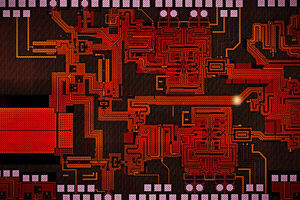
Data transfer system connects silicon chips with a hair’s-width cable
"The advance could improve energy efficiency of data centers and lighten the load for electronics-rich vehicles. Researchers have developed a data transfer system that can transmit information 10 times faster than a USB. The new link pairs high-frequency silicon chips with a polymer cable as thin a strand of hair. The system may one day boost energy efficiency in data centers and lighten the loads of electronics-rich spacecraft. The research was presented at this month’s IEEE International Solid-State Circuits Conference. The lead author is Jack Holloway ’03, MNG ’04, who completed his PhD in MIT’s Department of Electrical Engineering and Computer Science (EECS) last fall and currently works for Raytheon." [...]

Light unbound: Data limits could vanish with new optical antennas
"Researchers at the University of California, Berkeley, have found a new way to harness properties of light waves that can radically increase the amount of data they carry. They demonstrated the emission of discrete twisting laser beams from antennas made up of concentric rings roughly equal to the diameter of a human hair, small enough to be placed on computer chips. The new work, reported in a paper published Feb. 25 in the journal Nature Physics, throws wide open the amount of information that can be multiplexed, or simultaneously transmitted, by a coherent light source. A common example of multiplexing is the transmission of multiple telephone calls over a single wire, but there had been fundamental limits to the number of coherent twisted light waves that could be directly multiplexed. “It’s the first time that lasers producing twisted light have been directly multiplexed,” said study principal investigator Boubacar Kanté, the Chenming Hu Associate Professor in UC Berkeley’s Department of Electrical Engineering and Computer Sciences. “We’ve been experiencing an explosion of data in our world, and the communication channels we have now will soon be insufficient for what we need." [...]
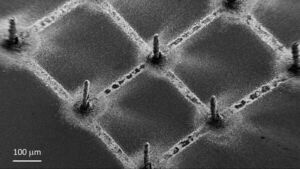
3D-printing perovskites on graphene makes next-gen X-ray detectors
"By using 3D aerosol jet-printing to put perovskites on graphene, scientists at EPFL have made X-ray detectors with record sensitivity that can greatly improve the efficiency and reduce the cost and health hazard of medical imaging devices. Since Wilhelm Röntgen discovered them in 1895, X-rays have become a staple of medical imaging. In fact, barely a month after Röntgen's famous paper was published, doctors in Connecticut took the first ever radiograph of a boy’s broken wrist. There has been a lot of progress since. Aside from radiographs, which most people have taken at least once in their lives, today’s X-ray medical uses includes fluoroscopy, radiotherapy for cancer, and computer tomography (CT), which takes multiple X-ray scans of the body from different angles and then combines them in a computer to generate virtual cross-sectional “slices” of a body. Nonetheless, medical imaging often works with low-exposure conditions, and therefore requires cost-effective, high-resolution detectors that can operate at what is called a “low photon flux”." [...]
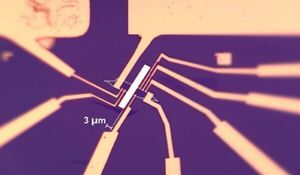
Putting graphene in a spin
"Researchers induce artificial ‘magnetic texture’ in graphene, a quantum science advancement that could help lead to more powerful semiconductors, computers Graphene is incredibly strong, lightweight, conductive … the list of its superlative properties goes on. It is not, however, magnetic — a shortcoming that has stunted its usefulness in spintronics, an emerging field that scientists say could eventually rewrite the rules of electronics, leading to more powerful semiconductors, computers and other devices. Now, an international research team led by the University at Buffalo is reporting an advancement that could help overcome this obstacle. In a study published today in the journal Physical Review Letters, researchers describe how they paired a magnet with graphene, and induced what they describe as “artificial magnetic texture” in the nonmagnetic wonder material. “Independent of each other, graphene and spintronics each possess incredible potential to fundamentally change many aspects of business and society. But if you can blend the two together, the synergistic effects are likely to be something this world hasn’t yet seen,” says lead author Nargess Arabchigavkani, who performed the research as a PhD candidate at UB and is now a postdoctoral research associate at SUNY Polytechnic Institute." [...]

The future of electronics is stretchy
"Stretchable electronic circuits are critical for soft robotics, wearable technologies, and biomedical applications. The current ways of making them, though, have limited their potential. A team of researchers in the Yale lab of Rebecca Kramer-Bottiglio, the John J. Lee Assistant Professor of Mechanical Engineering & Materials Science, has developed a material and fabrication process that can rapidly make these devices stretchier, more durable, and closer to being ready for mass manufacturing. The results are published in the journal Nature Materials. One of the biggest challenges for this area of electronics is to reliably connect stretchable conductors with the rigid materials used in commercially available electronics components, such as resistors, capacitors, and light-emitting diodes (LEDs). “The problem is that it's difficult to connect something soft with something rigid,” said Shanliangzi Liu, lead author of the paper and a former Ph.D. student in Kramer-Bottiiglio’s lab." [...]

Twin atoms: A source for entangled particles
"Quantum experiments that could previously only be performed with photons are now also possible with atoms: Beams of entangled atoms have been produced at TU Wien (Vienna). Heads or tails? If we toss two coins into the air, the result of one coin toss has nothing to do with the result of the other. Coins are independent objects. In the world of quantum physics, things are different: quantum particles can be entangled, in which case they can no longer be regarded as independent individual objects, they can only be described as one joint system. For years, it has been possible to produce entangled photons - pairs of light particles that move in completely different directions but still belong together." [...]
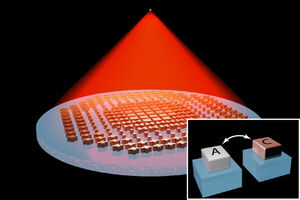
New “metalens” shifts focus without tilting or moving
"The design may enable miniature zoom lenses for drones, cellphones, or night-vision goggles. Polished glass has been at the center of imaging systems for centuries. Their precise curvature enables lenses to focus light and produce sharp images, whether the object in view is a single cell, the page of a book, or a far-off galaxy. Changing focus to see clearly at all these scales typically requires physically moving a lens, by tilting, sliding, or otherwise shifting the lens, usually with the help of mechanical parts that add to the bulk of microscopes and telescopes. Now MIT engineers have fabricated a tunable “metalens” that can focus on objects at multiple depths, without changes to its physical position or shape. The lens is made not of solid glass but of a transparent “phase-changing” material that, after heating, can rearrange its atomic structure and thereby change the way the material interacts with light." [...]

In step toward autonomous materials, researchers design patterns in self-propelling liquid crystals
"Breakthrough discoveries could pave way for new applications of liquid crystals Materials capable of performing complex functions in response to changes in the environment could form the basis for exciting new technologies. Think of a capsule implanted in your body that automatically releases antibodies in response to a virus, a surface that releases an antibacterial agent when exposed to dangerous bacteria, a material that adapts its shape when it needs to sustain a particular weight, or clothing that senses and captures toxic contaminants from the air. Scientists and engineers have already taken the first step toward these types of autonomous materials by developing “active” materials that have the ability to move on their own. Now, researchers at the University of Chicago have taken the next step by showing that the movement in one such active material—liquid crystals—can be harnessed and directed. This proof-of-concept research, published Feb. 18 in the journal Nature Materials, is the result of three years of collaborative work by the groups of Profs. Juan de Pablo and Margaret Gardel in the Pritzker School of Molecular Engineering at the University of Chicago, along with Vincenzo Vitelli, professor of physics, and Aaron Dinner, professor of chemistry." [...]
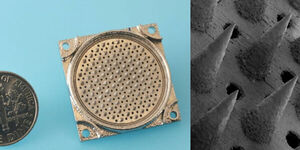
3D-Printed Thruster Boosts Range of CubeSat Applications
"Inexpensive and accessible electrical propulsion could be a boon for satellite-based Internet and Earth observing A new 3-D printed electric thruster could one day help make advanced miniature satellites significantly easier and more affordable to build, a new study finds. Conventional rockets use chemical reactions to generate propulsion. In contrast, electric thrusters produce thrust by using electric fields to accelerate electrically charged propellants away from a spacecraft. The main weakness of electric propulsion is that it generates much less thrust than chemical rockets, making it too weak to launch a spacecraft from Earth’s surface. On the other hand, electric thrusters are extremely efficient at generating thrust, given the small amount of propellant they carry. This makes them very useful where every bit of weight matters, as in the case of a satellite that’s already in orbit." [...]
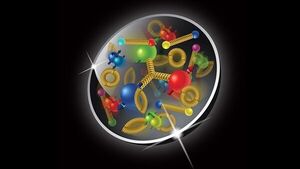
Nature’s funhouse mirror: understanding asymmetry in the proton
"Asymmetry in the proton confounds physicists, but a new discovery may bring back old theories to explain it. Symmetry — displayed in areas ranging from mathematics and art, to living organisms and galaxies — is an important underlying structure in nature. It characterizes our universe and enables it to be studied and understood. Because symmetry is such a pervasive theme in nature, physicists are especially intrigued when an object seems like it should be symmetric, but it isn’t. When scientists are confronted with these broken symmetries, it’s as if they’ve found an object with a strange reflection in the mirror. “Nature is leading the way for concepts in older models of the proton to get a second look.” — Argonne physicist Don Geesaman The proton, a positively charged particle that exists at the center of every atom, displays asymmetry in its makeup." [...]
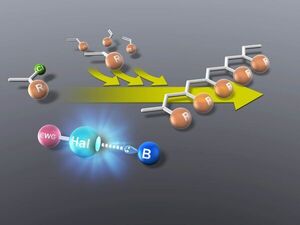
Fabricating the Future with a New Environment Friendly Method of Polymerization
"Many materials in the modern world―from the plastics that dominate it to the electronic chips that drive it―are constructed of polymers. Given their ubiquity and the evolving requirements of our world, finding better and more efficient methods of making them is an ongoing research concern. In addition, current environmental issues necessitate the use of methods and input materials that are environment friendly. Recent research by scientists from Nagoya Institute of Technology, Japan, has been in this vein, adding a new twist to a polymerization technique that has been around and successful since the 1980s: living cationic polymerization, where the polymer chain growth does not have the ability to terminate until the monomer is consumed. The scientists have, for the first time, demonstrated metal free organocatalysis for this reaction at room temperature for vinyl and styrene polymers, two of the most common polymers used in plastics. Their method is not only more efficient than current metal-based methods, but also environment friendly." [...]
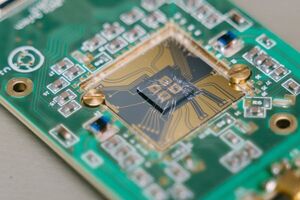
Quantum Shuttle to Quantum Processor Made in Germany Launched
"The quantum computer race is in full swing. Germany has long been one of the world leaders in basic research. An alliance between Forschungszentrum Jülich and the semiconductor manufacturer Infinion, together with institutes of the Fraunhofer-Gesellschaft (IAF, IPMS) as well as the Leibniz Association (IHP, IKZ), the universities of Regensburg and Konstanz and the quantum startup HQS, now aims to apply the results to industrial production. The goal is a semiconductor quantum processor made in Germany that is based on the "shuttling" of electrons and is to be achieved with technology available in Germany. The QUASAR project, which is funded with over 7.5 million euros by the Federal Ministry of Education and Research (BMBF), aims to lay the foundations for the industrial production of quantum processors over the next four years. Quantum computers have the potential to outperform conventional supercomputers by far in certain problems, for example when it comes to controlling traffic flows in metropolitan areas or simulating materials at the atomic level." [...]
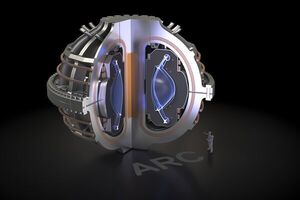
An aggressive market-driven model for US fusion power development
"National Academies study says fusion can help decarbonize US energy, calls for public-private approach to pilot plant operation by 2035-40. Electricity generated by fusion power plants could play an important role in decarbonizing the U.S. energy sector by mid-century, says a new consensus study report from the National Academies of Sciences, Engineering, and Medicine, which also lays out for the first time a set of technical, economic, and regulatory standards and a timeline for a U.S. fusion pilot plant that would begin producing energy in the 2035-40 time frame. To achieve this key step toward commercialization, the report calls for an aggressive public-private effort to produce by 2028 a pilot plant design that can, when built, accommodate any of the developmental approaches seeking to realize fusion’s potential as a safe, carbon-free, on-demand energy source. These include what it calls the “leading fusion concept, a deuterium-tritium fueled tokamak,” like that being pursued at MIT spinout Commonwealth Fusion Systems (CFS) with support from the Institute’s Plasma Science and Fusion Center (PSFC) and Department of Nuclear Science and Engineering. Martin Greenwald, deputy director of the PSFC, notes that “the report can be seen as confirming and validating the vision that motivated the founding of CFS in 2018.” The new report follows and extends a 2018 National Academies study that (while acknowledging the significant scientific and technical challenges still faced by fusion) saw promise in the tokamak approach, called for continued U.S. participation in the international ITER fusion experiment, and suggested a pilot plant effort . PSFC director and Hitachi America Professor of Engineering Dennis Whyte helped develop the new study as a member of the National Academies’ Committee on the Key Goals and Innovation Needed for a U.S. Fusion Pilot Plant, which also included representatives from other universities, national laboratories, and private companies." [...]
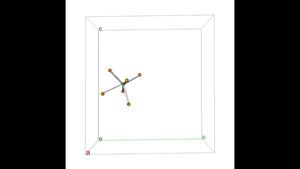
New Material is Next Step Toward Stable High-voltage Long-life Solid-state Sodium-ion Batteries
"A team of researchers designed and manufactured a new sodium-ion conductor for solid-state sodium-ion batteries that is stable when incorporated into higher-voltage oxide cathodes. This new solid electrolyte could dramatically improve the efficiency and lifespan of this class of batteries. A proof of concept battery built with the new material lasted over 1000 cycles while retaining 89.3% of its capacity—a performance unmatched by other solid-state sodium batteries to date. Researchers detail their findings in the Feb. 23, 2021 issue of Nature Communications. Solid state batteries hold the promise of safer, cheaper, and longer lasting batteries. Sodium-ion chemistries are particularly promising because sodium is low-cost and abundant, as opposed to the lithium required for lithium-ion batteries, which is mined at a high environmental cost." [...]
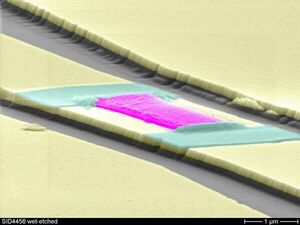
Spintronics: New manufacturing process makes crystalline microstructures universally usable
"New storage and information technology requires new higher performance materials. One of these materials is yttrium iron garnet, which has special magnetic properties. Thanks to a new process, it can now be transferred to any material. Developed by physicists at Martin Luther University Halle-Wittenberg (MLU), the method could advance the production of smaller, faster and more energy-efficient components for data storage and information processing. The physicists have published their results in the journal "Applied Physics Letters". Magnetic materials play a major role in the development of new storage and information technologies." [...]
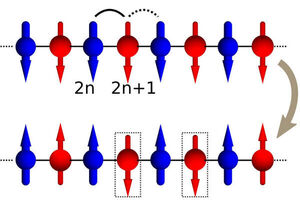
Lack of symmetry in qubits can’t fix errors in quantum computing, but might explain matter/antimatter imbalance
"Unexpected twist in the Kibble-Zurek theory offers a new approach to solving two famous physics problems regarding matter/antimatter asymmetry and isotope separation A team of quantum theorists seeking to cure a basic problem with quantum annealing computers—they have to run at a relatively slow pace to operate properly—found something intriguing instead. While probing how quantum annealers perform when operated faster than desired, the team unexpectedly discovered a new effect that may account for the imbalanced distribution of matter and antimatter in the universe and a novel approach to separating isotopes. “Although our discovery did not cure the annealing time restriction, it brought a class of new physics problems that can now be studied with quantum annealers without requiring they be too slow,” said Nikolai Sinitsyn, a theoretical physicist at Los Alamos National Laboratory. Sinitsyn is author of the paper published Feb. 19 in Physical Review Letters, with coauthors Bin Yan and Wojciech Zurek, both also of Los Alamos, and Vladimir Chernyak of Wayne State University. Significantly, this finding hints at how at least two famous scientific problems may be resolved in the future. The first one is the apparent asymmetry between matter and antimatter in the universe." [...]

Polymer film protects from electromagnetic radiation, signal interference
"The breakthrough combines excellent electromagnetic shielding with ease of manufacture and electrical isolation As electronic devices saturate all corners of public and personal life, engineers are scrambling to find lightweight, mechanically stable, flexible, and easily manufactured materials that can shield humans from excessive electromagnetic radiation as well as prevent electronic devices from interfering with each other. In a breakthrough report published in Advanced Materials—the top journal in the field— engineers at the University of California, Riverside describe a flexible film using a quasi-one-dimensional nanomaterial filler that combines excellent electromagnetic shielding with ease of manufacture. “These novel films are promising for high-frequency communication technologies, which require electromagnetic interference shielding films that are flexible, lightweight, corrosion resistant, inexpensive, and electrically insulating,” said senior author Alexander A. Balandin, a distinguished professor of electrical and computer engineering at UC Riverside’s Marlan and Rosemary Bourns College of Engineering. “They couple strongly to high-frequency radiofrequency radiation while remaining electrically insulating in direct current measurements.” Electromagnetic interference, or EMI, occurs when signals from different electronic devices cross each other, affecting performance. The signal from a cell phone or laptop WiFi, or even a kitchen blender, might cause static to appear on a TV screen, for example. Likewise, airlines instruct passengers to turn off cellphones during landing and takeoff because their signals can disrupt navigation signals." [...]
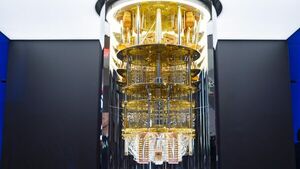
IBM's Quantum computer links two quantum revolutions
"Using the IBM Q computer, physicists at EPFL have verified for the first time the tight relationship between quantum entanglement and wave-particle duality, showing that the former controls the latter in a quantum system. “It is possible to do experiments in fundamental physics on the remotely accessible IBM Q quantum computer,” says Marc-André Dupertuis, a physicist at EPFL’s School of Basic Sciences. Working with Nicolas Schwaller, a Master student in Physics at EPFL, and Clément Javerzac-Galy, co-CEO of photonics company Miraex, the three scientists carried out their work by studying a system made of two separate quantum elements, represented in the IBM Q as superconducting quantum bits. EPFL already has a longstanding relationship with IBM’s famed quantum computer, with two teams of students placing second in the annual “IBM Q competition” in 2018 and 2020. The work is published in Physical Reviews A. “We were able to indirectly confirm that the duality of each quantum bit can be turned off completely, or set to any desired amount by controlling the degree of entanglement of the pair,” says Dupertuis." [...]
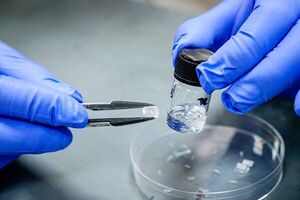
NTU Singapore researchers develop flexible crystal, paving the way for more efficient bendable electronics
"A team of researchers led by Nanyang Technological University, Singapore (NTU Singapore) has developed a new material, that when electricity is applied to it, can flex and bend forty times more than its competitors, opening the way to better micro machines. Conversely, when it is bent, it generates electricity very effectively and could be used for better “energy harvesting” – potentially recharging batteries in gadgets just from everyday movements. The novel material is both electrostrictive and piezoelectric. Its electrostrictive properties means it can change shape when an electric current is applied, while piezoelectric means the material can convert pressure into electric charges. When an electric field is applied, the atoms that make up electrostrictive materials shift, causing the material to deform and flex. When piezoelectrics are compressed, the pressure is converted to electric charges which accumulate in the material." [...]

Dishing up 3D printed food, one tasty printout at a time
"Researchers from Nanyang Technological University, Singapore (NTU Singapore), Singapore University of Technology and Design (SUTD) and Khoo Teck Puat Hospital (KTPH) have developed a new way to create “food inks” from fresh and frozen vegetables, that preserves their nutrition and flavour better than existing methods. Food inks are usually made from pureed foods in liquid or semi-solid form, then 3D-printed by extrusion from a nozzle, and assembled layer by layer. Pureed foods are usually served to patients suffering from swallowing difficulties known as dysphagia. To present the food in a more visually appetising way, healthcare professionals have used silicone moulds to shape pureed foods, which is labour and time intensive, and requires storage. While 3D food printing means food can be easily produced in a desired shape and texture in a shorter time, the dehydrated food and freeze-dried powders used as food inks usually contain a high percentage of food additives such as hydrocolloids (HCs) to stabilise the ink and enable a smoother printing process. High concentration of hydrocolloids usually changes the taste, texture and aroma of the printed food, making it unappetising to patients with dysphagia." [...]
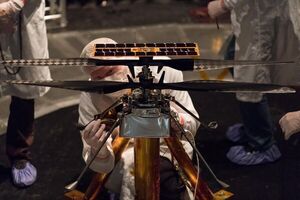
How NASA Designed a Helicopter That Could Fly Autonomously on Mars
"The Perseverance rover's Mars Helicopter (Ingenuity) will take off, navigate, and land on Mars without human intervention Tucked under the belly of the Perseverance rover that will be landing on Mars in just a few days is a little helicopter called Ingenuity. Its body is the size of a box of tissues, slung underneath a pair of 1.2m carbon fiber rotors on top of four spindly legs. It weighs just 1.8kg, but the importance of its mission is massive. If everything goes according to plan, Ingenuity will become the first aircraft to fly on Mars. In order for this to work, Ingenuity has to survive frigid temperatures, manage merciless power constraints, and attempt a series of 90 second flights while separated from Earth by 10 light minutes. Which means that real-time communication or control is impossible." [...]
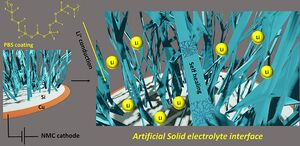
Packing More Juice in Lithium-Ion Batteries Through Silicon Anodes and Polymeric Coatings
"Scientists investigate how a self-repairing polymer can vastly improve the durability of a promising anode material for high-capacity batteries Although silicon anodes could greatly boost the capacity of Li-ion batteries, their performance rapidly degrades with use. Polymeric coatings can help solve this problem, but very few studies have explored the underlying mechanisms. In a recent study, scientists from Japan Advanced Institute of Science and Technology investigate how a poly(borosiloxane) coating greatly stabilizes the capacity of silicon anodes, paving the way for better and more durable Li-ion batteries for electric cars and renewable energy harvesting. Since their conception, lithium-ion batteries (LIBs) have been constantly improved and adapted so that they can become suitable for vastly different applications, from mobile devices and electric cars to storage units for renewable energy harvesters. In most larger-scale applications (such as the latter two), the focus of LIB research is placed on increasing their capacity and voltage limits without increasing their overall size. Of course, for that to be possible, the components and materials of the battery must be switched up." [...]
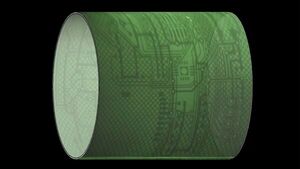
Ultra-high-resolution X-ray imaging of 3D objects
"New flexible X-ray sensor suitable for next-generation medical and industrial applications X-ray imaging is widely used in areas such as healthcare and forensic science, but existing X-ray machines are unable to capture curved three-dimensional (3D) objects at high resolution, and they are also relatively expensive. Now, an international team of researchers led by chemists from the National University of Singapore (NUS) has demonstrated a potential solution to overcome these limitations by using nanocrystals that can trap X-rays. The research, which was conducted with collaborators from Fuzhou University and The Hong Kong Polytechnic University, could be used not only for healthcare but also to detect defects in electronics, authenticate valuable works of art, or examine archaeological objects at microscopic scale. The findings were published in the prestigious journal Nature on 17 February 2021. A piece of rubber that detects X-rays In current machines, the X-ray detector is a flat panel where each pixel has its own integrated circuit. This makes the pixels bulky and limits the resolution of the detector." [...]
Documentação
A documentação é parte essencial do processo de aprendizagem e a Internet além de artigos interessantes de explorar também tem alguma documentação em formato PDF interessante de ler. Todos os links aqui apresentados são para conteúdo disponibilizado livremente pelo editor do livro.

The MagPI 103
"Inside The MagPi magazine #103 #MonthOfMaking. Discover new ways of making with Raspberry Pi. Easy Raspberry Pi Pico Projects. Don’t get stuck with Raspberry Pi’s new microcontroller. These projects help you get started. Recreate Amiga 600 with Raspberry Pi." [...]
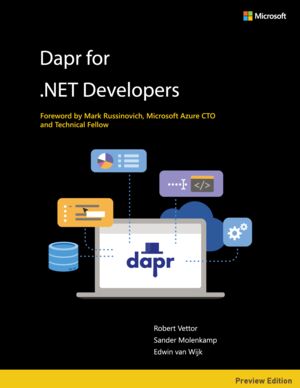
Dapr for .NET Developers
"With the wave of cloud adoption well underway, there is a major shift happening towards “cloud native” development, often built with microservice-architectures. These microservices are both stateless and stateful, and run on the cloud and edge, embracing the diversity of languages and frameworks available today. This enterprise shift is driven by both the market forces of faster time to market, as well as the scale and efficiencies of building services for the cloud. Even before COVID-19, cloud adoption was accelerating for enterprises and developers were being asked to do even more to deliver on building these distributed system applications, and that has only accelerated since. Developers in enterprises seek to focus on business logic, while leaning on platforms to imbue their applications with scale, resiliency, maintainability, elasticity, and the other attributes of cloud-native architectures, which is why there is also shift towards serverless platforms that hide the underlying infrastructure. Developers should not be expected to become distributed systems experts." [...]
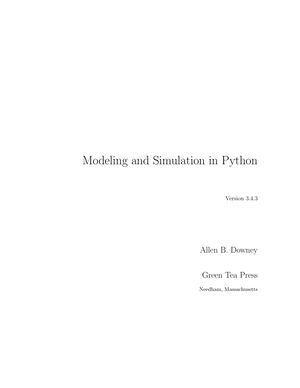
Modeling and Simulation in Python
"The essential skills of modeling — abstraction, analysis, simulation, and validation — are central in engineering, natural sciences, social sciences, medicine, and many other fields. Some students learn these skills implicitly, but in most schools they are not taught explicitly, and students get little practice. That's the problem this book is meant to address. At Olin College, we use this book in a class called Modeling and Simulation, which all students take in their first semester. My colleagues, John Geddes and Mark Somerville, and I developed this class and taught it for the first time in 2009. It is based on our belief that modeling should be taught explicitly, early, and throughout the curriculum." [...]

Computer Science I
"Several years ago our department revamped our introductory courses in a “Renaissance in Computing” initiative in which we redeveloped several different “flavors” of Computer Science I (one intended for Computer Science majors, one for Computer Engineering majors, one for non-CE engineering majors, one for humanities majors, etc.). The courses are intended to be equivalent in content but have a broader appeal to those in different disciplines. The intent was to provide multiple entry points into Computer Science. Once a student had a solid foundation, they could continue into Computer Science II and pick up a second programming language with little difficulty. This basic idea informed how I structured this book. There is a separation of concepts and programming language syntax." [...]
Projetos Maker
Diversos Projetos interessantes.
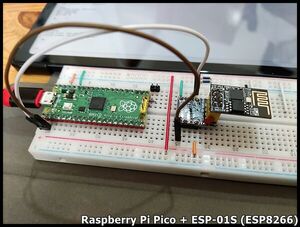
Connect ESP-01S (ESP8266) to Raspberry Pi Pico/MicroPython, using AT Command
"Just first connect ESP-01S to Raspberry Pi Pico/MicroPython UART, send AT-Command, set in Station Mode, connect to AP. " [...]

Arduino Nano- Switching ON/OFF Appliances Using Infra-Red Remote (Two Channel)
"The project presented here is a two-channel infrared remote ON/OFF switch that can be used to control home appliances, Lights, Fans, Water Pumps, Aquarium pumps, Ovens, Heaters, etc. This open-source project contains 2 x SSR (Solid State Relay), Arduino Nano, and TSOP1838 infrared receiver, keeping safety in mind, optically isolated SSR (Solid State Relay) is used to have isolation between high voltage AC circuitry and Arduino Nano. The operation of the circuit is pretty simple, TSOP1838/TSOP38238 IR Sensor receives the infrared signal from IR remote, Arduino Nano decodes the IR signal which is connected to digital pin D2 and provides latch outputs on digital pins D5, and D6 in respect to IR code received from IR remote. These two digital outputs D5, D6 drive the SSR using 2 x BC847 BJT transistors. CPC1998J optically isolated solid-state relays from IXYS Integrated Circuits drive the AC loads. We have tested this board with 500W/230V AC lamps, however, the load capacity of SSR is 20A." [...]

DIY Digital Soldering Station (Hakko 907)
"Build an affordable Homebrew Hakko 907 Digital Soldering Station! Enjoy the variable and constant temperatures that can reach up to 525C. The project only requires few components and roughly costs around $7 (excluding the repurposed power supply). Barely could I find detailed tutorials on one so I decided to make a video and Instructable about it. Project Specifications: Designed for Hakko 907 handles Compatible with similar handles Temperature Range: 27°C-525°C Warmup Time: 25s - 37s (325°C) Recommended Supply: 24V, 3A Power: 50W (Average) Regular Soldering Irons: Just like any other hobbyist, I started with a regular soldering iron. They're great but they do come with several cons." [...]

Heart Shape LED Lamp
"This is my first instructables project. you can join with mw to do more amazing project like this. In this project, we make a simple LED heart shaped flasher circuit using NE555 timer IC. This is simple LED flasher circuit only. I have replaced single LED with 24 LED in parallel. The main thing in this project is making LED heart shape." [...]

Solar Weather Station With ESP32, SIM800L, ESP8266, Sending Data to a WEB Server Over GSM/WiFi
"Let's make small weather station, collect sensor data, setup web server, send and display data. Already existing weather station projects on the internet made me wanna build weather station for myself. So I did it. Let me show you how. This is mainly based on Solar Powered WiFi Weather Station project from OpenGreenEnergy. For more information you can check video about this project." [...]
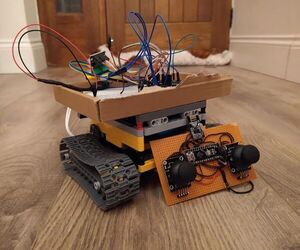
Arduino Controlled LEGO RC Tank and Transmitter
"I recently got my childhood Lego out and wanted to find a project that I could combine with Arduino and mechatronics. I started off building a digger but then realised a tank would be better because, well tanks are cool! I originally built it to be controlled over Bluetooth from my phone but then wanted to take it further and make a remote transmitter to make the connection more stable. Supplies: Receiver (tank) end: A bunch of Lego including tracks 2x geared DC motors 6v 5v portable power supply Arduino Uno or Nano L9110s motor driver NRF24L01 Remote Transceiver Breadboard Jumper Wires 10uf capacitor Transmitter end: Copper clad board or breadboard 2x joysticks Arduino nano (Uno would work) NRF24L01 Remote Transceiver 10uf capacitor Toggle switch" [...]
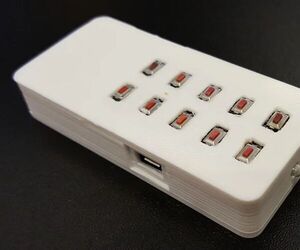
AT Tiny Techniques in a Macro IR Remote
"This instructable describes some techniques used in an ATTiny project. The project was to produce a simple macro remote control with a few buttons each of which can issue a series of IR remote controls to a variety of devices. The purpose was to allow controlling several devices with single button presses rather than have to remember and handle several different remote controllers. An example is to turn on a television, cable box and AV box. To accomplish with an ATTiny required some methods which are described in some detail. These methods have been used in the past but this instructable goes into their implementation in a bit of detail." [...]
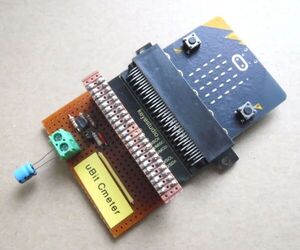
Microbit Capacitance Meter
"What is a capacitor? A device that stores electrical charge which in its basic form consists of two conducting plates separated by a dielectric. In addition to the basic parallel plate several other forms of construction exist an example being that the plates in the form of a metal foil allow the capacitor to be formed into a roll reducing its size. These basic types tend to be of low capacitance, polystyrene film being an example with capacitance of <=10nF and single layer ceramic up to ~1uF. Variants of these forms exist using different dielectrics and construction for a variety of different uses. Beyond the basic forms are the polarised (Electrolytic), types which employ a gel or liquid electrolyte with capacitance up to ~1F, used in coupling, decoupling, supply and timing applications." [...]

88888: the Electronic Smile Counter
"This project originated from a request of a friend. He asked me to build a so-called smile counter for their college dorm - a segmented display which can show a number. This number must increment every time someone pushed a button and should be memorized even if power goes out. The counter was counting smiles: every time a tenant would pass it by and was in a good mood, happy, smiling or anything in between, they would hit the button. In order to have a processing unit as simple as it can get (and to consume a few of the salvaged ICs I had, and still have on stock), I decided to build this using counters, decoders and buffers - at least on digit level. The main controller is an Arduino Nano I also had on stock." [...]
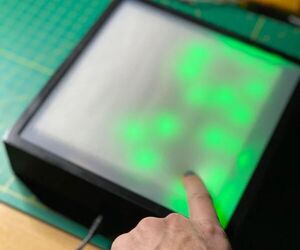
Calascere: a Modular Electronic Tile
"Calescere is a culmination of ideas and projects Majenta and Erika have been developing over the last couple of years. When Erika was asked to develop a concept for an interactive audio recording studio lobby, she and Majenta envisioned a space ripe with passive and active synchronized interfaces, these would seamlessly be integrated into the lobby’s furniture, floors, and walls, and they would control the ambient audio experience in the space. Imagine walking into a lobby where the ambient music is controlled by the footsteps of the people around you, the nervous tapping of the person waiting in the chair, the excited swaying of the artist leaning against the wall. More recently, at CES 2020 Majenta and Maddy, Loomia Founder, discussed how heated furniture has the potential to be a more sustainable strategy for heating in homes. We’ve seen through individualization of personal electronics (an app for everything evolving into now a device for every app), the appreciation of glowing aroma diffusers (sometimes combined with audio experiences), and through the design style of Google home and other products, that people are interested in interactive hardware experiences that go beyond the same rectangular touch screens over and over. People enjoy connected visual and audio feedback, and are looking for softer, less abrasive interactions with technology." [...]
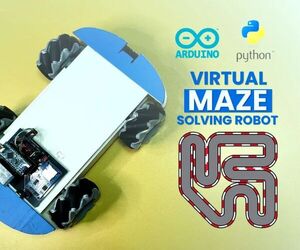
Virtual Maze Solver Robot
"Autonomous cars are now the most talked topics. Hobbyists try to make them using raspberry pi and computer vision technology. That's an approach. Another but easier way of making autonomous cars are line follower, path follower, maze solver robot. Such robots follow a certain color line drawn in certain environment's floor. We can make them using camera or IR sensor." [...]
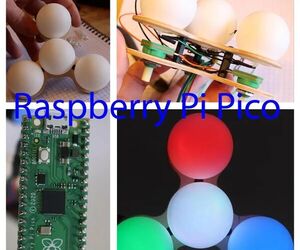
Raspberry Pi Pico Colour Changer.
"This is my first Raspberry Pi Pico project. This is the latest offering from raspberry pi and this time its not a SBC its a micro-controller. This is a new direction for the raspberry pi foundation and they have gone into it wholeheartedly by producing there own chip. But what do i think about it? well lets start with a simple project and see how it goes! This is basically a colour maker." [...]

Esp32 Based Wather Stations
"How to make Esp32 Based Wather Stations In this project, you’ll learn how to build an asynchronous ESP32 web server with the DHT11 that displays temperature and humidity using Arduino IDE. The web server we’ll build updates the readings automatically without the need to refresh the web page. With this project you’ll learn: How to read temperature and humidity from DHT sensors; Build an asynchronous web server using the ESPAsyncWebServer library; Update the sensor readings automatically without the need to refresh the web page. For a more in-depth explanation on how to use the DHT22 and DHT11 temperature and humidity sensors with the ESP32, read our complete guide: ESP32 with DHT11/DHT22 Temperature and Humidity Sensor using Arduino IDE Before proceeding to the web server, you need to wire the DHT11 or DHT22 sensor to the ESP32 as shown in the following schematic diagram. In this case, we’re connecting the data pin to GPIO 27, but you can connect it to any other digital pin. You can use this schematic diagram for both DHT11 and DHT22 sensors." [...]

Teardown of a quartz crystal oscillator and the tiny IC inside
"The quartz oscillator is an important electronic circuit, providing highly-accurate timing signals at a low cost. A quartz crystal has the special property of piezoelectricity, changing its electrical properties as it vibrates. Since a crystal can be cut to vibrate at a very precise frequency, quartz oscillators are useful for many applications. Quartz oscillators were introduced in the 1920s and provided accurate frequencies for radio stations. Wristwatches were revolutionized in the 1970s by the use of highly-accurate quartz oscillators. Computers use quartz oscillators to generate their clock signals, from ENIAC in the 1940s to modern computers.1 A quartz crystal requires additional circuitry to make it oscillate, and this analog circuitry can be tricky to design." [...]
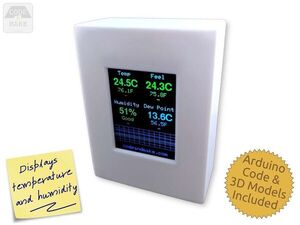
Arduino Thermometer Display
"A thermometer and humidity display that shows the current temperature, temperature index (feel), humidity level and dew point. For this project we are building an Arduino-based thermometer and humidity display. It shows the current temperature, temperature index (feel), humidity level and dew point. It also displays a graph of the readings from the past 12 hours. Parts If you plan to 3D print the case included with this project, you will need the exact components listed below. If you use alternative components they may not fit inside the case." [...]
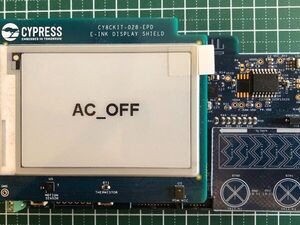
Voice Recognition Using PSoC6 BLE Pioneer Kit
"A device which can detect voice commands and takes action. Overview Voice recognition has played an important role in home automation and robotics to control systems. It helps in to create a touch-less, non-mechanical and low-cost controller. Until recently doing voice recognition on a limited resource microcontroller was not possible but after Tensorflow Lite and other similar efforts has made it possible. I could not found any ready to use example application which uses machine learning on a PSoC6 MCU with ModusToolBox. So I decided to port the Tensorflow Lite Micro SDK to the PSoC6 MCU with ModusToolBox using a PSoC6 BLE Pioneer Kit." [...]
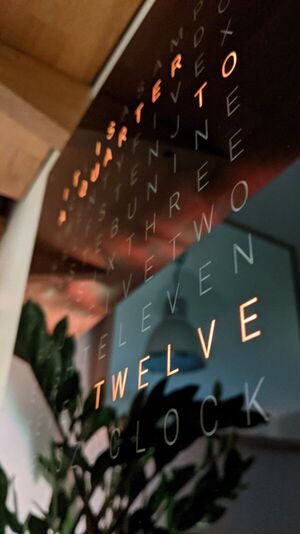
Wordclock
"ESP32 based DIY wordclock project Another take on the classic DIY word clock. This one requires a laser cutter but promises a very clean result and is quite cheap to make (about 50 €) while being feature packed with its 11x10 RGB LED matrix, RTC module (time setting survives power loss), light sensor, WiFi connectivity and more. This project was designed for the tools available in our makerspace. The largest square that can be cut in an Epilog Mini laser cutter is approximately 30x30cm, so the clock is designed around that constraint. " [...]
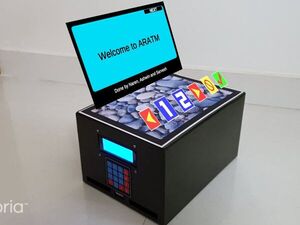
Ingenious UOI based augmented reality using SIFT for ATM
"ATM in Augmented reality for ease use. Story Augmented Reality is considered as a media that gives attraction and new experience for the users. Based on the previous research, it is stated that the use of Augmented Reality in banking brings a virtual experience for the users on transaction medium. A mobile application that uses Augmented Reality for banking may be considered as one of the methods to promote AR, because of the interactivity and virtual experience that the user can dispatch money from ATM without touching the keypad. " [...]
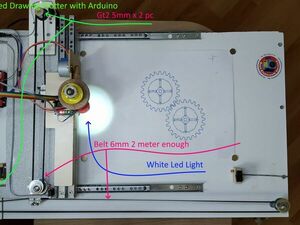
CNC plotter
"Gcode Controlled Drawing Plotter with Arduino I want to do a pen plotter. There are many plotter systems. I am doing it, the system that uses the belt. GRBL and Arduino CNC Machine Working Principle Overview The main parts I use for this are Arduino UNO R3 and CNC Shield, A4988 Step Motor Driver. My assembly parts list 1 x Arduino UNO R3 1 x USB Printer Cable 3 meter 1 x CNC Shield 3 x A4988 Stepper Motor Driver 2 x NEMA 17 Stepper Motor (For XY Axes) 1 x 28BYJ-48 5volt Stepper Motor (For up / down Pen Holder) 1 x 28BYJ-48 Driver board ULN2003 Chipset 1 x Bright White Led and 100 Ohm resistor for Pen Holder Light for the Draw on the A4 Paper 1 x Cabels for Arduino and Boards 4 or 6 x Limit Switch for Horning settings" [...]

Smart Greenhouse
"A complete functional unit for monitoring and controlling the internal environmental conditions of a greenhouse. This work was inspired by the effects of climate change taking place on our planet and affecting agriculture. It is immediately applicable to the optimization of agricultural production in greenhouses and contributes to slowing down the phenomenon of climate change through water and energy savings. For this purpose, a complete functional unit for monitoring and controlling the internal environmental conditions of a greenhouse was implemented using a microcontroller (Arduino) and the development of the appropriate software. Also with the internet connection you give us the possibility of remote monitoring and control from an android or iOS device (a common smartphone or PC), using the application created for this purpose. Although it did not exist at initial objectives of the work, at the process, export of automated crop yield measurements was achieved." [...]

Franzininho WIFI Board
"A development board to evaluate ESP32-s2 SoC and develop the new generation of Franzininho Boards The Franzininho project was created to develop skills in people in the areas of electronics and programming, through activities in the DIY format and in conjunction with maker culture in Brazil. Through the Franzininho DIY board, we reach thousands of people in Brazil. Many had their first contact with electronics by assembling their own Arduino compatible board and then moving on to programming it and creating their own applications. The accomplishment of this journey was a differential of the workshops of Franzininho DIY, taking the participants to go through several stages of an electronic project. During the workshops and with participants' feedback we noticed the need for a platform with more resources and programming possibilities for beginners, especially the public in the area of education, teachers, and elementary and high school students. Some signs developed by us recently, were born with this scenario in mind and helped to develop materials and workshops for this target audience." [...]
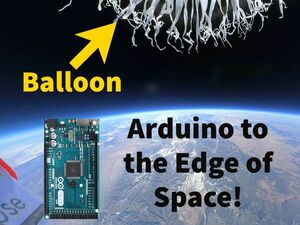
Arduino Powered Weather Balloon Datalogger
"Send your Arduino to collect data from the edge of space!! Hey everyone!! You're probably wondering, wait, you can send an Arduino to space? Almost. Using a weather balloon, you can send an Arduino, camera, garlic bread, or anything else you want to a third of a way to space! Even though it is a third of the way to space, almost 99% of the atmosphere isn't present, so we call it "the edge of space."" [...]

433 MHz receiver 8 channels with self-learning
"Self-learning UHF receiver consisting of a radio receiver board with Motorola decoding and a module equipped with 8 relays operating in impulse or bistable mode. In many home automation applications and in general where it is necessary to exercise remote control by radio of multiple devices installed in the same place, the classic single and dual-channel handheld transmitters are not particularly practical, because using common radio controls (TX/RX) should be installed more than one receiver, with an obvious increase in cost, space and complexity, since each receiver unit has redundant parts that could be pooled: for example the RF receiver. This is why it would be useful to have a single radio control system and, in particular, a receiver unit that supports all the channels required by the system; an example is a receiver described in these pages, which allows the remote management, via AM radio links at 433.92 MHz, of 8 users manageable with the clean contact of one relay each. It is, therefore, a radio control system in which we can combine a receiver with eight outputs, a single eight-channel transmitter, two four-channel, four two-channel, or eight single-channel transmitters, or combinations of them because the beauty of the receiver is that it learns the code regardless of which transmitter it comes from. Thanks to a suitable relay interface, the receiver can switch users either operating at low DC voltage or at 230Vac mains voltage, which absorbs up to 10 amps each. The coding used is the Motorola MC14502x standard, so it allows a maximum of 19,683 combinations for each channel unless you use multi-channel TX; in fact, in this case, the combinations must be divided by the total number of channels, but this limit is not derived from the receiver (which, as we will see, treats each code individually, regardless of the type of transmitter that generates it) but rather from the encoder of the transmitter." [...]
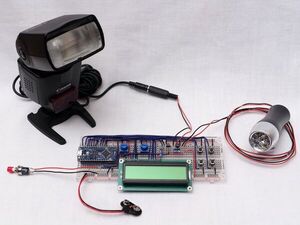
A Serious Stroboscope
"This stroboscope is a precise and versatile instrument which can be used to analyze periodic or fast motions. This stroboscope is said to be serious because it is not intended for fun or entertainment in the nightclubs. Rather it is a precise and versatile instrument which can be used to measure the rotation speed of a motor, or to analyze periodic movements such as that of a vibrating string. Optionally, it can be connected to an electronic flash in order to decompose and photography fast motions. Moreover, it can be synchronized on an external signal in order to convert it into a timing light, which can be used to set the ignition time of an old car engine. Principles It is designed around an Arduino Nano Every." [...]

Build a TinyML Smart Weather Station with Wio Terminal!
"Learn to build your very own smart weather station powered by machine learning, from data acquisition to training to deployment! In today’s tutorial, learn to create your own Wio Terminal Smart Weather Station with TinyML powered prediction capabilities! This article is a complete step-by-step guide to get this project up and running with your Wio Terminal, all the way from data acquisition to training, and finally deploying our smart weather station with Arduino code. Smart Weather Station: Project Overview Typically, a weather station project would involve connecting the sensor to our microcontroller platform and reading out this data in real time, either on an LCD display or over an internet connection to an online database. Today, I want to share the smart version of this weather station project that I created by adding the capability for our Wio Terminal to predict the current weather conditions. With an onboard TensorFlow Lite model, the Wio Terminal becomes able to use real time temperature and relative humidity data for making half-hourly weather predictions!" [...]
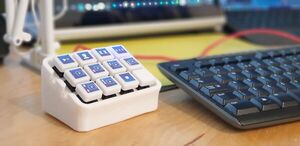
Pico Producer
"This project is an OBS Controller using a Raspberry Pi Pico and CircuitPython. " [...]
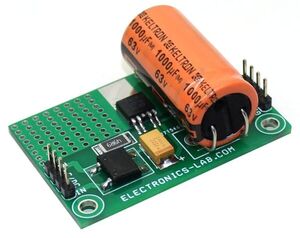
60V Input – 5V @ 50mA Output High Voltage Fixed Output Regulator
"This is a high voltage regulator project that provides 5V regulated output with a load capacity of 50mA from input supply 10V to 60V. The project is based on the ZXTR1005K4 regulator which is fully integrated into a TO252 package. We have tested this project with 60V DC input, but the project can take higher voltage input up to 100V, please refer to the datasheet below for more info, and don’t forget to change the capacitor C1 with a higher voltage rating. Components: CN1 Supply Input AC/DC , BR1 Bridge Rectifier converts AC voltage into pulsating DC Voltage, R1 current limiting resistor use 1 ohm to 50ohms, Capacitor (C1) smoothing capacitor converts the full-wave rippled output of the rectifier into a more smooth DC output voltage, U1 High Voltage regulator, Capacitor (C2, C3) filter capacitor on the output. Features: - Supply Input 10V to 60V DC or 6V to 40V AC - Output 5V DC, Load Up to 50mA - AC/DC Input - Series Resistor to Limit the Input current - Large Size Capacitor on input DC Bus for Low Ripple Output - Tantalum Capacitor at Output for Stable Output - PCB Dimensions 50.80 x 34.29 mm" [...]
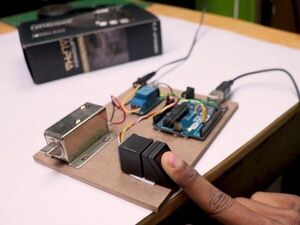
DIY Fingerprint Door lock System
"How to make DIY Fingerprint Door lock System using r307 fingerprint module In this tutorial we are going to learn how to record or register fingerprints with Arduino and then read them with the biometric sensor and activate a lock. " [...]
DIY a stock tracking device
"This device can help you view your current stock holdings through a small screen. I will make some secondary market investments in my spare time. Usually these tasks can be done only in the mobile app. But I think it is also very interesting to use a hardware device to check stock information, so I made this project, hope you like it. Features of the project View real-time information of individual stocks, including, Real-time stock price Ups and downs Holding cost Number of shares View the overall position information, including, Total assets Total profit and loss Profit and loss of the day Total yield Hardware connection The hardware setup is very easy, you only need to connect the I2C_LCD to the I2C interface on the Squama Ethernet, and connect the Suqama RJ45 interface to the router. If your router supports PoE, you don’t need to supply power via USB after the code is burned." [...]
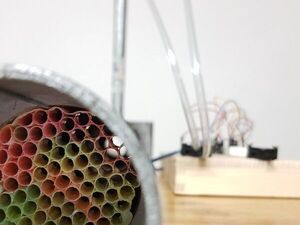
Orifice Plate and Fluid dynamics!
"It's a device which allows you to compute the mass flow within a pipe. The implementation with arduino is very easy. WHAT DO YOU NEED TO KNOW? Physics, Fluid dynamics (Reynold's number, Bernoulli equation), Numerical Analysis. WHAT DO YOU NEED? An Orifice Plate (there are different types of it, the model "D and D/2 tappings" is the easiest to build, so I recommend it to you, but if you want to learn more about the other prototypes, check the UNI ISO 5167-1-2 2003) Arduino UNO MPX 5050dp thermocouple MAX 6675 HOW DOES IT WORK?" [...]
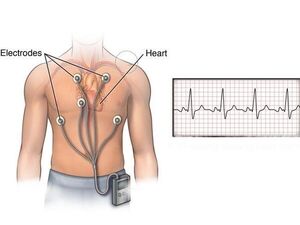
DNN Based Homemade ECG
"Due to High cost of ECG this project aims to be cost-effective still be able to perform early detection of Heart Problems According to the WHO, Heart disease is major part of deaths among the adults, and the treatment is very expensive which is not affordable by the poor people, So what if we try to build one using cheap products yet satisfying results. The aim of this project is to develop a functional and cost-effective device that can detect heart patologies. This device will allow people to diagnosis their heart themselves which is both cost-effective and easy. Solution:- We are proposing to build a small yet effective and low-cost portable device, which can do ECG in real time. It consist of a main board with high processing power (like the STM32F429ZI) to read the ECG signal and a Raspberry Pi Display to show the Real-time results of the analysis. Nowadays ECG equipments are both expensive and bulky." [...]
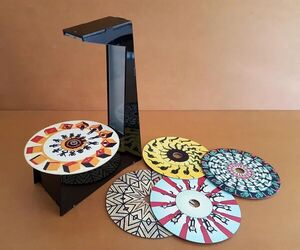
A Modern Take on the Phenakistoscope
"The Phenakistoscope is an early optical illusion device that uses static images to create the illusion of motion through the principle of persistence of vision. It is regarded as one of the first forms of moving media entertainment that paved the way for the motion picture industry. We are not sure how big is the community currently interested in phenakistoscopes, however, from browsing through the internet, there seems to be quite a huge interest in this subject. If you do not know how a phenakistoscope works, you may visit https://youtu.be/r4B3FHHt_k8 to see one in action. It may be amazing to watch the mirror reflected images come to life by peeking through the slits or slots of phenakistoscopes, however, it can be quite tiresome when viewing for an extended period of time. In this instructable, we are going to build a modern phenakistoscope." [...]
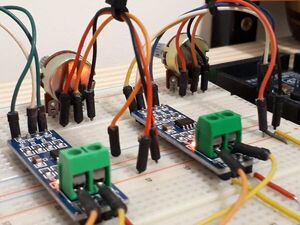
How to Communicate 3 or 32 Arduinos via RS-485
"You'll learn how to create an automation system to communicate 3 Arduinos via RS485. What project will you develop? The project consists of 3 Arduino's. We have an Arduino UNO, a Nano, and a MEGA. The Arduino UNO will control the other 2 and send commands to receive the reading of the analog signal from the potentiometer connected to each Arduino. He will receive the signal and present it on the LCD screen." [...]
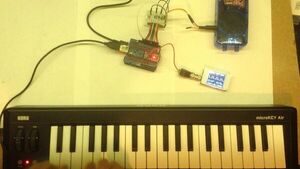
Arduino Tone Polyphony
"I’ve been reading about the Oskitone 555Poly which looks like a lot of fun. It is a fully polyphonic sound generator based on one 555 oscillator circuit per key, each one individually tuned to the note you want it to play. Unfortunately my budget for making is unlikely to be able to justify getting one myself, but the full development, build and design details are available on github here and it makes for fascinating reading. This project is not attempting to “build my own” but I was inspired by the idea of an oscillator per key and so I thought I’d spectacularly miss the point of the Oskitone and attempt to use a microcontroller to give me a tunable oscillator output for as many keys as I could manage. In the process, I’ve managed full 12-note polyphony (as long as you only need 12 notes in total) on an Arduino Uno. Here is how it works." [...]

Auto calibrate hx711 scale with known weight
"Scale smart solution I got a 4point load cell scale to sort out, and I thought it’s a good time to create a code that will allow me to calibrate it once and store that date in the eeprom. In the video I go over the process in the code and demonstrate the end result. In order to explain the calibration process we need to go over some basic things. The received data from the hx711 is a 24bit resolution analog to digital read. In order to know what’s that in pounds or in kilo, we need to have a ratio factor. So If we read the data from the hx711 then place 3Kg on the scale and read the data again, the delta divided by 3 will give us that ratio factor we need." [...]
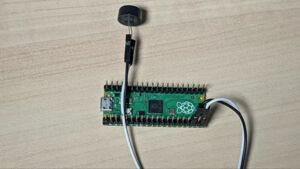
How to Use a Buzzer to Play Music with Raspberry Pi Pico
"With a cheap piezo buzzer, you can set alarms or play whole tunes. Whether you’re building a game that beeps when you lose a turn, an alarm clock that wakes you up or just a cute display that plays 8-bit music, a low-cost piezo buzzer can be a great part of your Raspberry Pi Pico project. The extremely-cheap buzzers -- you can often find them for less than $1 apiece -- are dead-simple to program in MicroPython and can even vary the frequency to produce musical notes. There are two types of piezo buzzers: active and passive. Active buzzers will make noise if they are just hooked up to power with no microcontroller involved while passive ones will not. Passive buzzers are preferred for this kind of project because they offer a better range of sounds, though in our testing, both worked." [...]
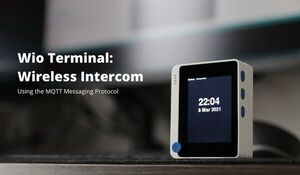
Build an MQTT Intercom with Wio Terminal
"Create your own wireless intercom for easy and non-intrusive communication around the house! Also doubles as a desk clock. In today’s article, we are going to build an Arduino wireless intercom with our Wio Terminal! This project sets up your Wio Terminal as a desk clock, but also allows you to send and receive messages to other devices via the MQTT protocol. Wireless Intercom Background & Overview I had dinner at a friend’s place over the Lunar New Year holidays, and they had trouble calling everyone to the table. That’s when someone aptly remarked that some kind of intercom would be so useful!" [...]

Arduino Breath Controller for Cheap (USB-MIDI)
"Introduction In this project we will build a simple USB MIDI plug-and-play breath controller. It is designed using easy to find cheap components so that the total cost remains affordable and well below commercial equivalents. This is the basic version that only uses the air pressure sensor but the plan is to upgrade it to include a bite and nod/tilt sensor in the future. The project assumes some very basic electronics and Arduino knowledge but even a beginner can build it as there is no soldering involved. Of course more advanced users can solder everything on a perma-protoboard. I am not covering installation of the IDE/libraries and instructions to upload code as there are excellent tutorials on the internet." [...]

Class-D Audio Amplifier
"In this project, a GreenPAK™ SLG46140V is used to create a Class-D Audio Amplifier In this project, we will use a Dialog GreenPAK™ SLG46140V to create a Class-D Audio Amplifier. A Class-D amplifier takes an analog audio signal, converts it into a digital PWM signal, and then filters the PWM signal to recapture the analog signal with a greater amplitude for greater volume. Below we described steps needed to understand how the solution has been programmed to design the audio amplifier. However, if you just want to get the result of programming, download GreenPAK software to view the already completed GreenPAK Design File. Plug the GreenPAK Development Kit to your computer and hit the program to design the solution. Input and Output Signals Figure 1 shows the input and output signals used in this project." [...]
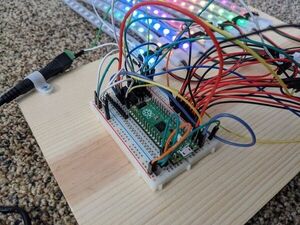
NeoPIO: Drive lots of LEDs with Raspberry Pi Pico
"The new RP2040 microcontroller from Raspberry Pi Foundation has a powerful feature: the PIO module, a sort of accelerated I/O processor. In this guide, you will learn how you can use CircuitPython and PIO together to drive 8 separate NeoPixel LED strands using just 3 GPIO pins and a 74HC595 Shift Register. One advantage of driving your NeoPixel LEDs this way is that less time is spent actually sending the pixel data to the LEDs—It is about 7.5x faster to show() your NeoPixels with the parallel method. Depending on your project, having parallel strips as opposed to chained strips can also make for better wiring. Mostly, this guide is just a cool way to show off some of the capabilities of PIO itself. " [...]
Secção Videos
Videos interessantes.
That's all Folks!




